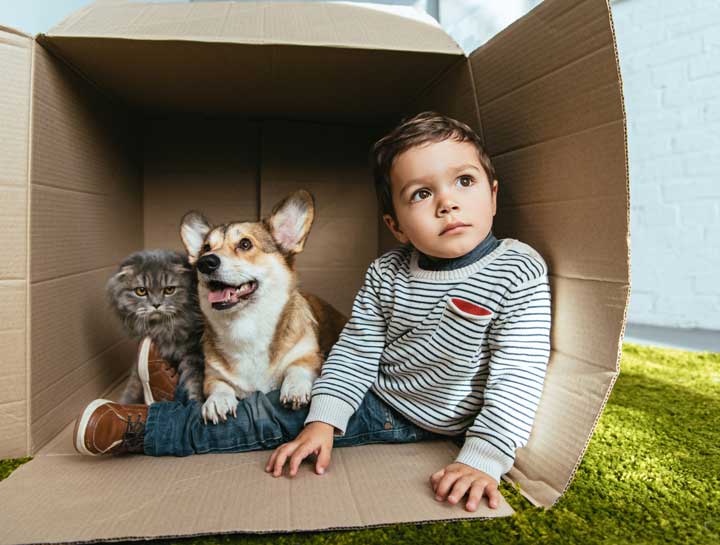Moving With Dogs and Cats (2 of 3): Tips for Moving Day

Your pet’s moving day is here!
Here are moving day tips, so you can keep your dog or cat as comfortable as possible during this big change.
The essentials
Tip #1: Keep a dedicated container of pet supplies with you.
Here are some essential items we recommend having handy for moving day:
- Familiar pet food
- Water bowl
- Daily or monthly medications (diabetes meds, heartworm pills, etc.)
- Favorite toys
- Familiar bedding
- Leash
- Collar
- Car sickness medication and/or anti-anxiety medication
- Your cat’s litter and litter box
- Your pet’s medical history, including vaccinations
- Enzymatic cleaner and paper towels (for accidents in the car or unexpected marking in your new home)
Using your pet’s favorite toys and bedding helps lower stress. Why? These items smell like home!

Tip #2: Make sure your pet is wearing a collar with an ID tag.
If your dog or cat isn’t used to wearing a collar, you can expect a little testiness. (You know we’re talking about you, kitties.) Put the collar on anyway.
Being able to identify your pet and contact you is so important if he or she gets loose!
Tip #3: Keep your pet in a safe, enclosed area in your home while the movers are in and out (if you haven’t lined up a kennel, daycare, or friend to watch your furry friend).
For example, you may want to put your dog or cat in a bathroom that doesn’t have any boxes.
This will help keep your pet out of trouble and lower the need to repeatedly open and close the room’s door.
Make the space cozy and comfortable for your pet with familiar bedding, toys, and fresh water.
If you know your pet has a tendency to get into trash cans or toilet paper, take these temptations out of the space while your dog or cat is in there.
Car rides (particularly long ones) and hotel stays
Tip #4: Have car sickness medication or anti-anxiety medications handy.
If you know your dog or cat has issues in the car, give them the meds in advance.
If you’re unsure how your pet will do on a long car trip, your current veterinarian may be able to give you trial courses of these meds to make sure they work and help you avoid any behavioral surprises on your trip!

Tip #5: Bring plenty of food and water with you.
It’s important to make sure your pet stays hydrated.
Give your cat or dog water every two to four hours or so.
While stress may affect your pet’s appetite, familiar food can help lower the potential for gastrointestinal issues.
(It’s normal for stress to create issues with your cat’s bladder or give your dog diarrhea.)
Tip #6: Bring your cat’s litter box with his or her own litter.
Cats can be very finicky about where they do their business!
They may not adapt well to a new litter box or new litter, so stick with what they know to help avoid accidents outside the box.
Tip #7: Make sure you have toys and a familiar bed packed.
Familiar items can help decrease your pet’s stress and help your furry friend adapt to your new surroundings.
These items smell like home!
Plane trips
Tip #8: Get your dog or cat to use the travel carrier in advance of your trip.
You may want to start by leaving the carrier door open with treats inside and/or feeding your pet inside it.
That way, your pet has a positive association with the travel carrier.
Tip #9: Make the travel carrier comfortable.
We suggest putting a couple of absorbent pads under the bedding your pet will be laying on.
The pads can help keep the carrier dry.
You also may want to include a small bowl of food and water, as well as any favorite toys, to keep your dog or cat occupied and lower stress.

Tip #10: Get your pet to go potty before the trip.
We know this can be tricky with cats. Do your best!
Tip #11: Get ready to make your pet comfy when he or she lands.
Be sure to have a towel, enzyme cleaner, and clean bedding with you when you pick your pet up, in case your furry friend had an accident in the carrier.
We also suggest having fresh water and food ready. Hydration is the most important thing. If your dog or cat doesn’t have an appetite upon arrival, that’s okay and normal.
Check out our other articles on moving with pets:
- Planning tips for a move with a dog or a cat (tips for before you move)
- Preparing and settling into your new home with pets (what to expect after you move)
